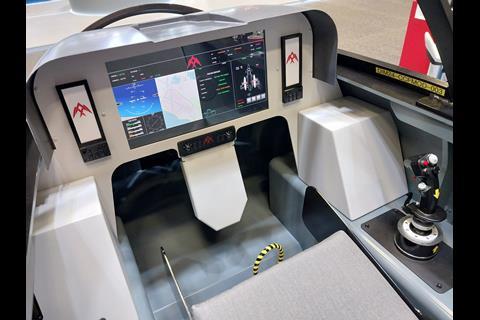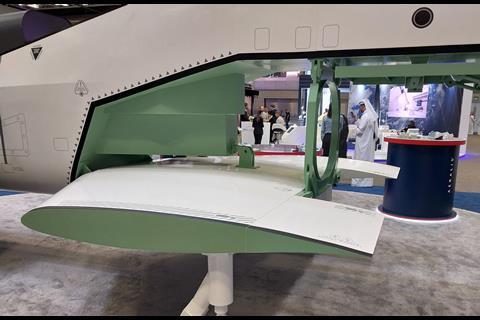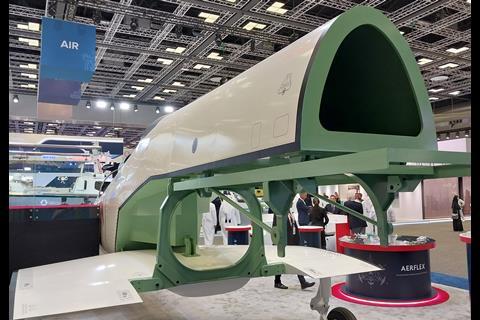UK developer Aeralis has unveiled the common core fuselage design that will be at the heart of its modular family of military aircraft, with the structure on display at the DIMDEX exhibition in Doha, Qatar.
On show as a full-scale mock-up, the structure is described as “an accurate representation of the aircraft that is currently being designed and built”.

Aeralis plans to fly a single-engined test platform named Phoenix in 2026, which chief executive Tristan Crawford says will be close to a production-standard asset. Service entry for an operational system is targeted around 2030.
Forming part of a major exhibit by Qatar’s Barzan Holdings – an investor in the Aeralis project – the company’s display also includes a flight simulator rig, along with the EDM-built mock-up.
The device is being used to demonstrate the developmental aircraft’s reconfigurable avionics system, named Aerosa, which will enable common cockpit displays to mimic the capability of those found in fourth- and fifth-generation fighters.
A central part of the Aeralis development is the use of the Pyramid open architecture system developed by the UK Royal Air Force’s (RAF’s) Rapid Capabilities Office.
Aeralis is already working with the UK Military Aviation Authority with an eye to aircraft certification requirements, and aims to also secure joint approvals from the UK Civil Aviation Authority and the European Union Aviation Safety Agency.
Using its common core fuselage design, Aeralis plans to produce a range of models for operational use, including a single-engined basic trainer, twin-engined advanced jet trainer, light-attack variant and an aggressor/surrogate training platform to support frontline types including the Eurofighter Typhoon and Lockheed Martin F-35.
It also is eyeing the future training requirements of the RAF with regard to the UK’s Global Combat Air Programme partnership with Italy and Japan, and believes its high-subsonic-speed platform could be adapted for such an application.
Other potential roles for its modular aircraft could include intelligence, surveillance and reconnaissance, in-flight refuelling, uncrewed tasks or use from an aircraft carrier. Aeralis says such a family of products could feature more than 85% parts commonality, delivering significant cost savings to operators.
The common core fuselage is the result of extensive redesign work outlined by the airframer at the DSEI show in London last September. Crawford notes that versus earlier concepts, its front cockpit is now capable of accommodating the full range of pilot sizes, and additional internal fuel capacity thanks to its wing moving to the base of the fuselage.
Aeralis also is using the 4-6 March show to outline a future service provision model named Aerflex. This promises to “release air forces from the burdens of capital outlay and fleet management” by “passing responsibility for ownership, maintenance and availability to industry”, it says.


































